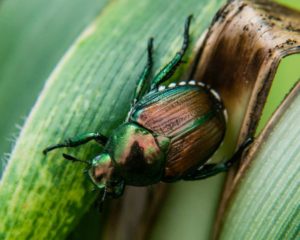Japanese Beetles
go.ncsu.edu/readext?610510
en Español / em Português
El inglés es el idioma de control de esta página. En la medida en que haya algún conflicto entre la traducción al inglés y la traducción, el inglés prevalece.
Al hacer clic en el enlace de traducción se activa un servicio de traducción gratuito para convertir la página al español. Al igual que con cualquier traducción por Internet, la conversión no es sensible al contexto y puede que no traduzca el texto en su significado original. NC State Extension no garantiza la exactitud del texto traducido. Por favor, tenga en cuenta que algunas aplicaciones y/o servicios pueden no funcionar como se espera cuando se traducen.
Português
Inglês é o idioma de controle desta página. Na medida que haja algum conflito entre o texto original em Inglês e a tradução, o Inglês prevalece.
Ao clicar no link de tradução, um serviço gratuito de tradução será ativado para converter a página para o Português. Como em qualquer tradução pela internet, a conversão não é sensivel ao contexto e pode não ocorrer a tradução para o significado orginal. O serviço de Extensão da Carolina do Norte (NC State Extension) não garante a exatidão do texto traduzido. Por favor, observe que algumas funções ou serviços podem não funcionar como esperado após a tradução.
English
English is the controlling language of this page. To the extent there is any conflict between the English text and the translation, English controls.
Clicking on the translation link activates a free translation service to convert the page to Spanish. As with any Internet translation, the conversion is not context-sensitive and may not translate the text to its original meaning. NC State Extension does not guarantee the accuracy of the translated text. Please note that some applications and/or services may not function as expected when translated.
Collapse ▲Hordes of shiny metallic green destroyers emerge from the ground to feed on fresh, young foliage. They ravage the landscape turning plant leaves to lace. Within a month or so, the siege is over, until next year…
Sounds somewhat like the plot of a horror movie; however, Japanese beetles are very real. Reports of their emergence have been coming in from Lee County, so if you haven’t seen them this year, you will soon.
Japanese beetles have been in the eastern United States since 1916. They are considered one of the most damaging pests in the landscape as they attack a wide variety (over 300 species) of landscape and fruit plants.
The Japanese beetle begins life in the ground as a white grub. Grubs eat turf roots and when high populations are present, turf will wilt or die. This leaves the lawn feeling spongy and soft. There are other white grubs in North Carolina – they are the larvae of other beetles.
Grubs feed on roots from July through October. In November, grubs burrow deeper in the soil to escape the cold. In March, the grub resumes feeding on roots and in late May, adult beetles emerge. Adult beetles have two goals: to eat and to reproduce. The female beetle lays 40 to 60 eggs in damp soil. She can lay eggs 12 or more times. No wonder we see so many beetles!
So what about control? Controlling the adult beetles is a nearly constant battle. Handpicking adults into soapy water will destroy them, but can be an hourly task.
Japanese beetle traps work by using certain scents to attract the adults. Traps can catch up to 75% of the beetles that approach them, but can only be effective if an entire area uses them (for example, a neighborhood). If traps are placed throughout a neighborhood, the beetle population may be reduced by about 30%. Traps must be emptied every one to two days to prevent odors that may attract other animals and repel beetles.
Some plants are highly susceptible to insect feeding, while others are more resistant. Some of their favorites include roses, crape myrtles, grapes, and fruit trees. When designing your landscape in a beetle-ridden area, try to incorporate resistant plants such as arborvitae, coralbells, flowering dogwood, holly, pine, red maple, and juniper. A more complete list is available at our Center.
There are a number of chemicals registered for use on Japanese beetles, but many require consistent applications throughout the summer months. Chemicals that are taken up by the plant through the soil (also called systemic) are available for use on the beetle. If you chose a chemical control, be sure to read and follow the label.
Grub control will help reduce the damage to your lawn, but will not control the adult population since adults can fly in from other areas. If your turf has been showing signs of grub feeding, examine the turf root system in April and August. Use a spade to cut a 1-square foot section of sod and roll it back to inspect the turf. Repeat in several locations. If you find more than 10 grubs per square foot on average, control is necessary.
Biological control using the bacterial disease milky spore is available, but results have been disappointing and may not justify the cost.
Chemical insecticides may be applied, if an infestation has been found, from August through October. There are some preventative chemicals that may be applied prior to July if there is a history of infestation. Many times irrigation prior to treatment is highly recommended to move the grubs closer to the soil surface. Be sure to read and follow the label carefully.
Japanese beetles are a difficult pest to control, but there are a number of strategies available. For more information on Japanese beetles, contact us at 919-775-5624 or reference:
Minda Daughtry is Horticulture Agent for North Carolina Cooperative Extension in Lee County.





